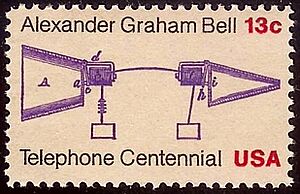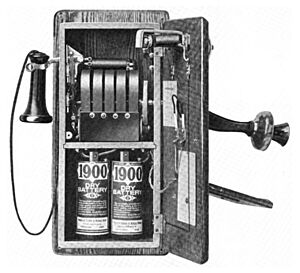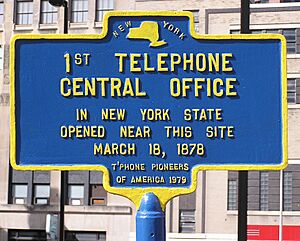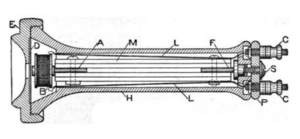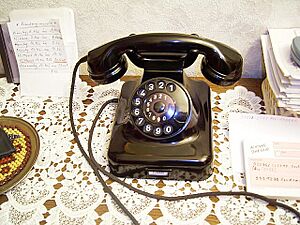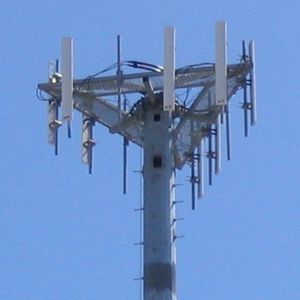History of the telephone facts for kids
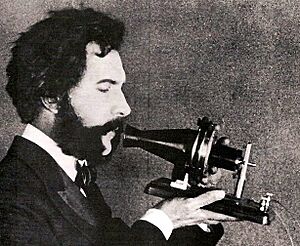
The story of the telephone is about how this amazing device was created and improved over time. It all started with earlier ways to send messages. The very first patent for the telephone was given to Alexander Graham Bell in 1876.
Contents
Early Sound Devices

Before electric telephones, people used mechanical devices to send sounds. These devices could carry speech and music farther than normal talking. The simplest example is the "tin can telephone," which has been around for hundreds of years. It uses two cups or cans connected by a tight string. When you speak into one cup, the sound makes the string vibrate. These vibrations travel along the string to the other cup, letting someone hear you from a distance.
One of the first scientists to experiment with these string phones was Robert Hooke in the 1600s. An old version of a string phone was also found in Peru, made by the Chimu people around 700 AD. It used gourds and stretched animal hide.
For a short time in the late 1800s, some companies tried to sell acoustic telephones. But they couldn't compete with the new electric telephones because their range was very limited. Speaking tubes, which are like long pipes, were also common in buildings and on ships for talking between rooms. They are still used today!
Electric Message Machines
The telephone grew out of the electrical telegraph. This was a machine that sent messages using electricity, usually in codes like Morse code.
In 1804, a Spanish scientist named Francisco Salva Campillo built an early electric telegraph. Later, in 1816, Francis Ronalds in England made a working telegraph using static electricity. Other inventors like Pavel Schilling and Carl Friedrich Gauss also created electromagnetic telegraphs in the 1830s. Gauss and Wilhelm Eduard Weber even built a telegraph that connected two buildings in Germany.
The first commercial electric telegraph was used in England in 1839. It ran along a railway line for about 13 miles.
In the United States, Samuel Morse developed his own electric telegraph in 1837. His assistant, Alfred Vail, helped him create the famous Morse code. Morse sent America's first telegraph message in 1838.
Who Invented the Telephone?
Many people argue about who truly invented the electric telephone. Inventors like Antonio Meucci, Alexander Graham Bell, and Elisha Gray all played important roles. The early history of the telephone was full of lawsuits as many people and companies fought over who owned the patents. However, the patents given to Bell and Thomas Edison were the most important for making the telephone a successful business.
-
Philipp Reis, 1861, built the first device he called a "telephone."
-
Elisha Gray, 1876, designed a telephone using a special water microphone.
-
Tivadar Puskás suggested the idea of a telephone exchange in 1876.
-
Thomas Edison invented the carbon microphone, which made telephone signals much stronger.
The modern telephone is the result of many people's work. But Alexander Graham Bell was the first to get a patent for it. He called it a machine for sending "vocal or other sounds telegraphically." Because of this, Bell is usually given credit for inventing the first practical telephone.
Johann Philipp Reis was the one who first used the word "telephon" for his device. Edison even said Reis was the "first inventor of the telephone." The U.S. House of Representatives has also recognized the Italian-American inventor Antonio Meucci for his work on the telephone.
There was a big argument between Elisha Gray and Alexander Bell. People wondered if they invented the telephone separately, or if Bell copied Gray's idea. This debate is part of the larger question of who deserves credit for the invention.
In 2002, the U.S. House of Representatives passed a resolution recognizing Meucci's contributions. However, the Canadian Parliament later passed its own motion, saying Bell was the inventor.
Telephone Exchange
Before telephone exchanges, telephones were connected directly to each other, usually just two at a time. This was useful for connecting a home to a business, like a simple intercom. But it wasn't practical for everyone to call everyone else.
A telephone exchange is a central place that connects many different telephone lines. It allows people to call each other from their homes, businesses, or public places. This made telephones much more useful and led to a whole new industry.
The idea for the telephone exchange came from the Hungarian engineer Tivadar Puskás in 1876. He was working for Thomas Edison at the time. The very first commercial telephone exchange opened in New Haven, Connecticut, on January 28, 1878. It started with 21 customers.
A man named George W. Coy designed and built this first switchboard. He was inspired by Alexander Graham Bell, who had talked about the idea of a telephone exchange in a lecture. Coy's switchboard was made from simple things like carriage bolts and teapot handles. It could connect up to 64 customers, but only two calls could happen at the same time.
The company grew quickly. By February 1878, it had 50 customers. Most of these were businesses like doctors' offices, the police, and the post office. Only a few homes had phones. The company later became the Southern New England Telephone company.
Early Telephone Improvements
Here are some key moments in the telephone's early history:
- 7th Century AD: The Chimu culture in Peru used string telephones made from gourds and hide.
- 1667: Robert Hooke invented a string telephone that sent sounds using vibrations.
- 1854: Antonio Meucci showed an electric voice device in New York.
- 1861: Philipp Reis built the first telephone that could send speech.
- 1871: Antonio Meucci filed a patent notice for his "Sound Telegraph."
- 1876: Bell signed his patent application for the telephone.
- February 1876: Elisha Gray designed a liquid transmitter for a telephone.
- March 7, 1876: Bell received his U.S. patent for the telephone.
- March 10, 1876: Bell made his famous first call: "Mr. Watson, come here! I want to see you!"
- August 10, 1876: Bell made what some call the "world's first long-distance call" in Ontario, Canada.
- 1877: The first experimental telephone exchange was set up in Boston.
- 1877: Emile Berliner invented the telephone transmitter.
- January 14, 1878: Bell showed the telephone to Queen Victoria in the UK. She found it "quite extraordinary."
- January 28, 1878: The first commercial U.S. telephone exchange opened in New Haven, Connecticut.
- 1877-1878: Thomas Edison invented and improved the carbon microphone. This microphone was used in almost all telephones until the 1980s. It made the sound much clearer and louder.
- 1887: Tivadar Puskás introduced the multiplex switchboard, which was a big step for telephone exchanges.
- 1915: The first telephone call across the entire U.S. was made, from New York City to San Francisco.
- 1927: The first phone call across the Atlantic Ocean was made, from the U.S. to the UK.
Early Telephones
Early telephones came in many designs. Some used liquid transmitters, but these were soon replaced. Most used Edison's carbon transmitters, which made the sound much louder. These carbon microphones needed special coils and a battery to work.
At first, telephones were powered by a battery right at the user's home. Later, a "common battery" system became popular. This meant the power came from the telephone exchange through the same wires that carried the voice.
The very first telephones had only one wire for sending and receiving sound. They also had only one opening for sound, so you had to listen and speak into the same hole.
Initially, people would lease telephones in pairs, for example, one for their home and one for their shop. They would then hire someone to connect the two phones with a wire. If they wanted to talk to more places, they needed more pairs of phones.
To get someone's attention, early users would whistle into the phone! Soon, telephones were given a bell. At first, the bell needed a separate wire, but later it could use the same wire as the voice.
In the 1890s, a new, smaller telephone style appeared, called the "candlestick telephone." It had three parts: a tall stand for the speaker (like a candlestick), a separate earpiece that hung on a hook, and a box for the bell and other parts. This design made it easier for users to hang up the phone properly.
As time went on, telephone lines improved. Instead of single wires, twisted pairs of wires were used to reduce noise. For long-distance calls, special sound-proof booths were set up with the newest technology.
By 1893, Sweden had the most telephones per person, especially in its capital, Stockholm. The U.S. caught up and became the world leader in telephone use after Bell's patents ended in the 1890s.
20th-Century Developments
By 1904, over three million phones in the U.S. were connected by manual switchboards. By 1914, the U.S. had more telephones per person than any other country. In 1927, the first commercial telephone line across the Atlantic Ocean was tested.
A very popular and long-lasting telephone design appeared in the early 1900s. It combined the speaker and earpiece into one handle, which rested in a cradle on a base unit. This base unit later also held the bell and other parts. Instead of local batteries, power came from the central telephone office.
For the next 50 years, the telephone network grew much larger and more efficient. The telephone itself didn't change much until Touch-Tone dialing started replacing the rotary dial in the 1960s.
The history of mobile phones began with two-way radios in vehicles like taxis and police cars. Later, "bag phones" could be carried around.
In 1947, engineers at Bell Labs suggested using hexagonal "cells" for mobile phone signals. This idea led to modern cellular technology, but it took until the 1960s for the electronics to be developed.
In 1956, the first transatlantic telephone cable (TAT-1) was laid. This, along with international direct dialing, helped connect telephone networks around the world.
On April 3, 1973, Martin Cooper of Motorola made the first cellular phone call in front of reporters. This marked the start of handheld mobile phones.
Digital Telephone Technology
The rapid growth of digital telephone technology was made possible by MOS (metal-oxide-semiconductor) technology. The MOSFET (MOS field-effect transistor) was invented in 1959. MOS technology led to chips that could combine analog (voice) and digital signals.
These advancements led to PCM (pulse-code modulation) codec-filter chips in the late 1970s. These chips became the standard for digital telephones. By the 1990s, telephone networks were mostly digital, using these chips in telephone exchanges and other equipment. The speed of digital communication networks has grown incredibly fast, thanks to the shrinking size of MOS technology.
British companies developed the digital push-button telephone in 1970, using MOS chips. These phones could convert button presses into pulse signals for older telephone exchanges. They also introduced a new feature: storing phone numbers for speed dialing. Between 1971 and 1973, Bell developed the "Touch-O-Matic" telephone, which could store up to 32 numbers.
Women and the Telephone
The telephone played a big part in modernizing society. It helped suburbs grow and allowed homes and businesses to be separate. Historically, and even today, women often use the telephone to connect their homes with the outside world, like making doctor's appointments or arranging meetings.
21st-Century Developments
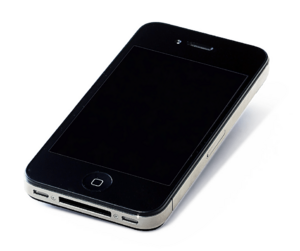
In the 21st century, Internet Protocol (IP) telephony, also known as Voice over Internet Protocol (VoIP), has become very popular. This technology uses the internet to send conversations as data. VoIP can replace traditional phone services and even compete with mobile phones by offering free or cheaper calls over WiFi.
The biggest development in the 21st century is the smartphone. This amazing device combines a small computer, a cell phone, a digital camera, and internet access. Its touch screen makes it easy to dial numbers and do many other tasks. Smartphones also allow for email, music, and video.
See also
- Carbon microphone
- History of mobile phones
- History of telecommunication
- History of videotelephony
- Private branch exchange
- Push-button telephone
- Telephone exchange
- Timeline of the telephone
- Telegraph in United States history
- Telephone in United States history
- Invention of the telephone
- Bell Telephone Memorial, a monument to the telephone's invention
- Charles Bourseul – claimed inventor of the telephone
- Elisha Gray
- Elisha Gray and Alexander Bell telephone controversy
- Innocenzo Manzetti
- Johann Philipp Reis – claimed inventor of the telephone
- Antonio Meucci – claimed inventor of the telephone
- The Telephone Cases, court cases about the telephone's invention
- Thomas Edison's carbon telephone transmitter – improved sound quality


